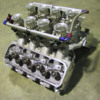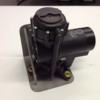quote:
Kelly, no doubt you can probably alter the signal by changing the line size, so I suppose the larger line size would provide the most accurate signal and mimic a shared plenum design.
Large lines improve response time. If you overdo it, they can also create a lot of signal noise with a small plenum. Small lines dampen noise and worsen transient response which defeats the ability to emulate traditional speed density MAP type signal tune. You can potentially get some improved off idle and low Rs behavior but above that it all looks like WOT to the MAP sensor any way. How much time do you spend below 2krpm rpm? -About zippo for me but I live in a rural area with lots of smooth back roads and don’t do much city driving with my car nor do I care too.
quote:
Something brought up to me with a local head porter was the reversion wave from a big overlap cam throwing the map signal off as well. Something I was concerned about was the port mismatch between the IR manifold and the heads. The local porter mentioned that a slight mismatch could help reduce the wave cleaning up the signal. I'm bringing him the manifold and heads to see how much of a mismatch would be acceptable, because his idea of a mismatch could be different than what I'm looking at.
I wouldn’t rely on port mismatch to address this. For reversion pulse dampening, the mismatch would need to be smaller runner than head port window and most of those situations only enjoy some benefit if any up to a certain port velocity and then fall on their face. Aren’t you the other way around (runner bigger than port window)? I can’t really tell from your pictures but the one I can see looks like the manifold is considerably wider on one side (1/4” maybe?) perhaps A3 port width? I’d fix the mismatch if I was you. Is your intake aluminum or mag? Get some aluminum filled epoxy and have at it.
quote:
I don't foresee any major changes in the setup once I get it going, so an N-alpha map could work no problem. If I can get it to work in closed loop, the engine may run better at part throttle being able to utilize a larger map as opposed to the limited map based on just rpm and throttle position to assume load with N-Alpha.
Like I said above, if you’re going to spend a lot of time in this range, might be worth it to you but be prepared for a lot of fiddling around.
quote:
This single plane could be adapted to EFI, but the Kinsler should theoretically make more power assuming I can get it matched closer.
In a high state of tune, you may actually be able to get more peak HP out of the 4barrel open plenum than the IR unit. However, I would contend you could get more area under the torque curve in a say ~3krpm range with better street manners at low Rs going IR. Like most things, depends upon how well your selected parts play together.
quote:
Here you can clearly see the difference between the taller SVO abc port and the more squared shorter yet wider yates port. It appears offset as well.
Are these older C3s with standard Clev valve train and angles or the modern Yates C3 variants?
quote:
after talking with Earl at Kinsler he basically said that n-alpha was probably the only solution due to the limited voltage range the map sensor will provide given the cam and the rest of the setup.
Thus my previous comment that if you don’t expect to see big changes in altitude; just go N-Alpha and call it a day.
quote:
Makes sense so I guess at this point I have to decide if I want the convenience of the IAC. I ran the demon with no choke and it wasn't a big deal to me, so I guess I need to figure out how bad I want it to start without holding the pedal down slightly while it warms up.
Yup!














